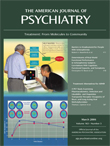Euphorigenic and Abusive Properties of Modafinil
To the Editor:
In the August issue of the Journal, Charles P. O’Brien, M.D., Ph.D. (1) stated the following about modafinil, a drug that he reported may decrease cocaine use in some cocaine users: “The medication has not been reported to produce euphoria, and there has been no indication of excessive use or abuse in clinical trials” (p. 1428). As the scientific basis for his comment, the author referenced his own group’s work (2).
The author’s statement does not appear to be supported by his referenced work, nor is it supported by information widely available in the 2004 edition of the Physicians’ Desk Reference (PDR). The referenced article, for example, may demonstrate that modafinil can, in some cases, blunt cocaine euphoria. However, it does not say anything about modafinil’s intrinsic ability to produce euphoria (or not). Separately, the 2004 PDR raises specific concerns about modafinil, saying that it can produce “psychoactive and euphoric effects, alterations in mood, perception, thinking and feelings typical of other CNS stimulants.” The PDR also states that “modafinil is reinforcing, as evidenced by its self-administration in monkeys previously trained to self-administer cocaine.”
The author’s comment about the lack of euphorigenic effects of modafinil is also contradicted by the U.S. Food and Drug Administration (FDA) in its warning letter of Jan. 14, 2002, sent to Paul M. Kirsch, the senior director of regulatory affairs of Cephalon, Inc., the makers of modafinil. It is available online (3). That letter specifically reiterates the package insert for modafinil, addressing its abuse potential and euphorigenic effects.
That the euphorigenic side effects or abuse potential may be minimized has current treatment implications because modafinil is increasingly promoted for fatigue and excessive sleepiness unrelated to narcolepsy as well as for cocaine abuse. However, the implications loom even larger because the makers of modafinil have submitted the “reformulated” drug to the FDA under a new name—Attenace—for the treatment of attention deficit hyperactivity disorder (4).
1. O’Brien CP: Anticraving medications for relapse prevention: a possible new class of psychoactive medications. Am J Psychiatry 2005; 162:1423–1431Link, Google Scholar
2. Dackis CA, Kampman KM, Lynch KG, Pettinati HM, O’Brien CP: A double-blind, placebo-controlled trial of modafinil for cocaine dependence. Neuropsychopharmacology 2005; 30:205–211Crossref, Medline, Google Scholar
3. Rogers JR: FDA Warning Letter to Paul M Kirsch, Senior Director, Regulatory Affairs, Cephalon Inc re: NDA #20-717, Provigil (modafinil) Tablets, MACMIS ID #10183, Jan 14, 2002. http://www.pharmcast.com/WarningLetters/Yr2002/Jan2002/Cephalon0102.htmGoogle Scholar
4. Cephalon Files Application for Marketing Approval of New Modafinil Formulation for the Treatment of Children and Adolescents With Attention-Deficit/Hyperactivity Disorder. West Chester, Pa, Cephalon, Dec 21, 2004. http://www.drugs.com/NDA/attenace_041221.htmlGoogle Scholar



